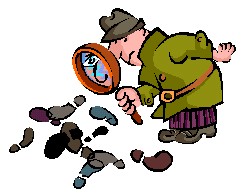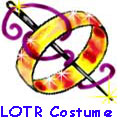Researching Sources for Movie Costumes

by Cat Devereaux - v2.0
A wonder image-rich movie often inspires us to recreate
costumes. We want to capture a
piece of the film's art... or sometimes, just to relive the
fun of the movie. Regardless of your reason, the techniques are the
same. Costumes from the movies can be researched
in many ways. Here I'm going to list some of the standard resources.
Beginners: do not worry if you cannot recreate every
detail. Do the research and then make the decision of which parts you
are going to recreate based on your sewing skills, time and budget.
Main sources:
We are lucky that Lord of the Rings has numerous books out.
Many movies will not even have a single book . The movie books have
only a limited number of pictures but they're gems. It can be a great
research tool because the pictures are such high resolution. If you
use a magnifying glass or jewelers loop you can pick up details that you
would not see any other way.
One problem can happen when you are looking for costume
details is that the main photos are optimized for
the actor's face... not the costume. The lighting may push the costume
into the background. Sometimes the area around the face has actually
been touched up to get rid of distracting objects such as buttons and
jewelry (or to tone them down) so
nothing pulls attention from the actor's face. This sometimes also
includes seam lines and finishes if they draw the eye. (Example
Aragorn's leather jerkin is completely edged in a fold over strip of leather
that is sewn down. In a prominent picture or Aragorn from the end of
FOTR, this edge is brushed out all the way or partially depending on where
it is in the jerkin.)
There are five LOTR books out so far... and another, an art
book, due this
summer. For a review of which of these are best for the costume you
are researching, go <here>.
Related to the large color photographs in the books is the concept of the 8x10 glossies.
However,
they are normally only head and shoulder shots. If you get the
official studio
ones you've got high contrast details. Watch out for the touch-ups
though. On the other hand, if you buy some of the "convention"
glossies, these have been copied from everything, including a VCR tape... so
resolution is gone. Just remember, watch your sources!
The DVD is always a great source for costuming detail,
especially if your computer can print still pictures from it. Watch
for resolution loss both when you save and when you print. Added features
like the extra commentary or making-of sections will have
more costume bits. The sad part... you have to wait months for it to
come out. So, start your research else where.
In February, Nation Geographic released "Beyond the Movie:
The Lord of the Rings: the Fellowship of the Ring". This DVD is a mix
of travel log and cultures. However, it has a number of segments on
both the hobbits and the elves. Some of the footage is video showing
extra of the hobbits. The elven background people were cut from the
movie, but bits are show here.
The August DVD release will be the same movie as released in
the theatres at the end of 2001. It will have the extras that were
aired on TV before the release of LOTR: FOTH. The November release
will have an extended version that add extra hobbit and elf scenes as well
as extends many of the character relationships. This version will have
more in-depth making-of specials.
An exhibit of the costumes can be absolute pay dirt --
especially if you are allowed to photograph the clothing. This varies by
exhibit. When all else fails, bring a sketch book. You can see
the true color of the fabric because film stock does affect what color you
see on the screen. You can see details that the camera never picked
up... like what's under Gandalf's beard or the bottom half on an outfit that
was never shown in the film. Also, this is a perfect place to figure
out the true fabrics.
They may choose to display props separately. There
you get a chance to see the fastenings and again do a color check. With
all the cloaks worn in LOTR this gives you a chance to pickup the extra
items that make up the character's entire outfit.
-
Casa Loma Exhibit in Toronto, Canada: This was the
first showing on the North American continent. We found links to
dozens of great pictures at
www.theonering.net. We labeled a lot of them and placed the links
in the Character section.
-
FIDM, Los
Angeles, CA: Every year the Fashion Institute of
Design and Merchandising puts on a pre-Oscar display of quite a few of the
"best" movie costumes of the year. The exhibit for the 2001
costumes were amazing, they outdid themselves. (BTW, bring
a sketch pad, no photos.)
The Media - TV and Magazines
TV specials about the-making-of a movie will show you how
the costumes move... so have your VCRs ready. Even if the special gives
no information beyond what has been handed out in press releases, you get
many more views of the costumes. Seeing the costumes move is a gem.
It gives you a better idea about the fabric and construction when someone
rides, jumps, swirls, dances or fights. You may see the character with
and without their cloak or coat.
Now-a-days movies are heavily promoted in everything from
fashion magazines to fan magazines to industry specials. These will
often give you the first peak of the costumes, sometimes six months out.
These images will be very controlled. However, you may find behind-the-scene
pictures here that are invaluable later for figuring out construction
details. Don't expect these pictures to come out on the web.
What is happening with the LOTR pictures is unusual. The studio has
been incredibly tolerant about the pics that have shown up all over the web. You need to go
out and pick up the magazines. You will find the magazines pictures
have good resolution. However, shots shown will be very limited.
Pictures
Looking up pictures on the web can be very appealing.
It's fairly quick, costs nothing but time and you don't even leave your
keyboard. However, the web is an always evolving thing.
What is here today may not be there tomorrow. You are at the mercy of
a web master's whim. Also, the quality of the images can very
greatly. Legitimate press sites will have very high quality images
because their pictures come from the studio itself. However, the number
of photo's will probably be limited.
Many pictures found out on fan sites have been resized and
resaved a few times. Since most of these images are jpg's to begin
with, each save looses more information and you loose the fine low-contrast
details of seams, trim, fabric and embroidery. Still other images, in
total disregard of copyright laws, have
been scanned in from books, magazines, newspapers or even captured off a
video taped TV special. So, their resolution was never good to begin
with. However, these home grown sites will have a lot more spy and fan photos out
there than official sites. They are also organized very differently.
This gives
you much more of a chance of finding what you need to show costume details
of hems, sleeves and boots.
Different types of pictures to look for:
-
a good head shot - to get collar and shoulder details
-
a wider studio portrait shot - should give you most from the
waist and up, but these are not always available.
-
check the action shots for a full view of the costume
including footwear since you will seldom get a full portrait
-
action shots with the clothes swirling will show inside
details including belts and shirts and sometimes you will get back views.
-
behind the scenes shots show costumes and actors in ways
that they never were intended in film. Great way to figure out layers
and get a better look at colors.
If you are bookmarking links there are a few things to
consider when you find the same picture on different sites. Find the
"official" images off of press sites first. These will be the clearest
and have the most resolution. If you find the image multiple places,
get the one that is not in a database, since database links are much more
likely to change. (That's easy to tell. The links with the
question marks come from databases and are also longer.) When using
fan sites, the ones run by groups are normally more stable than the
individual sites. Also, pick the English language sites over the
foreign language sites, to make searching easier... and often faster.
Information
Finding web information about the costumes is an entirely
different kind of search. The official site is always a good place to
start. Searching though all the press archives of the papers can be an
entirely different thing. Quickly, you will find most of the stories
are the same. Information often came from the press releases or a herd
of reporters on junkets that ask the same questions (and get the same
answers).
Don't get too frustrated, there are some gems of information, but you have to
go though a lot of similar articles to find these. Book mark them
right away because all the different paper's names blend after a while.
These searches can pay off for finding out about fabrics,
yardage and odd details. You can find out where the designers got their inspiration
sometimes. This helps you pick a historical pattern to modify. If
you find out the designer had the outfits made in a city, then you can
search the garment districts for some of the same finds. (In the case
of LOTR, fabrics are from India and other sources far away from the normal
Hollywood design houses, so this suggestion will not work in this
instance... but it often does.)
Do not stop at just the current movie. If you can look at
other design projects the costume designer has worked on. You may see
variations or get an idea on how she/he likes to pattern and construct.
Remember, never use just one source if you
are really trying to get the details right.
LOTR Home | The Hobbit | News 'n' Exhibits | Characters | Quick Costumes | Making 'Em | Buy It | Resources | Community | Search Us | Contact Us
Up | From Hobbits to Elves | Of Masks, Men and Vast Designs | Many Cultures of the Ring | Research Links | Researching Sources | Book Reviews
This page was last updated
04/22/08
|



